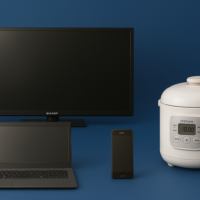Japanese Consumer Goods Sales
ဂျပန် လူသုံးကုန်ပစ္စည်းများရောင်းဝယ်ရေး
Key Aspects of Japanese Consumer Goods Sales:
Market Segmentation:
- Consumer goods in Japan can be categorized into various segments, including electronics, food and beverages, fashion, personal care, and household products. Understanding consumer preferences in these segments is crucial for successful sales strategies.
Quality and Innovation:
- Japanese consumers prioritize quality and craftsmanship. Brands that focus on delivering high-quality, innovative products tend to perform well in the market. The “Made in Japan” label often signifies excellence and reliability.
E-commerce Growth:
- Online shopping has seen significant growth in Japan, especially after the pandemic. Consumers are increasingly turning to e-commerce platforms for convenience and a broader range of products. Local retailers are adapting by enhancing their online presence and offerings.
Consumer Trends:
- Trends such as sustainability, health-consciousness, and an interest in local products are shaping purchasing decisions. Brands that align with these trends and communicate their values effectively tend to resonate better with consumers.
Retail Environment:
- The retail landscape in Japan includes traditional department stores, specialty shops, and convenience stores. Each channel has its own unique shopping experience, and understanding these differences can enhance sales strategies.
Cultural Influences:
- Cultural factors significantly influence consumer behavior in Japan. Marketing strategies that respect cultural norms and integrate local traditions tend to be more successful.
Strategies for Success in Japanese Consumer Goods Sales:
- Localized Marketing: Tailor marketing efforts to fit local tastes and customs to build trust and brand loyalty.
- Quality Assurance: Emphasize quality control and the benefits of your products to attract discerning Japanese consumers.
- Innovative Promotion: Utilize social media and influencer marketing to reach younger consumers who may prefer modern shopping experiences.
- Customer Engagement: Foster relationships with consumers through excellent customer service and engagement on digital platforms.
Japan’s consumer goods market presents both challenges and opportunities. Companies that adapt to the local market dynamics and consumer preferences can achieve success in this unique and rewarding environment.
ဂျပန်လူသုံးကုန်ပစ္စည်းများရောင်းချခြင်း၏ အဓိကသော့ချက်များ-
၁.စျေးကွက်ခွဲဝေခြင်း-
-ဂျပန်နိုင်ငံရှိ လူသုံးကုန်ပစ္စည်းများကို အီလက်ထရွန်းနစ်၊ အစားအသောက်နှင့် အဖျော်ယမကာများ၊ ဖက်ရှင်၊ တစ်ကိုယ်ရည် စောင့်ရှောက်မှုနှင့် အိမ်သုံးပစ္စည်းများ အပါအဝင် ကဏ္ဍအမျိုးမျိုးဖြင့် အမျိုးအစားခွဲခြားနိုင်သည်။ အောင်မြင်သော အရောင်းဗျူဟာများအတွက် ဤအပိုင်းများရှိ စားသုံးသူအကြိုက်များကို နားလည်ရန် အရေးကြီးပါသည်။
၂.အရည်အသွေးနှင့် ဆန်းသစ်တီထွင်မှု-
-ဂျပန်စားသုံးသူများသည် အရည်အသွေးနှင့် လက်မှုပညာကို ဦးစားပေးကြသည်။ အရည်အသွေးမြင့်ပြီး ဆန်းသစ်တီထွင်ထားသော ထုတ်ကုန်များကို ပေးပို့ရန် အာရုံစိုက်သော ကုန်အမှတ်တံဆိပ်များသည် ဈေးကွက်တွင် ကောင်းမွန်စွာ လုပ်ဆောင်လေ့ရှိပါသည်။ “ဂျပန်နိုင်ငံထုတ်” တံဆိပ်သည် ထူးချွန်မှုနှင့် ယုံကြည်စိတ်ချရမှုကို မကြာခဏ ကိုယ်စားပြုသည်။
၃.E-ကူးသန်းရောင်းဝယ်ရေး တိုးတက်မှု-
-အထူးသဖြင့် ကပ်ရောဂါပြီးနောက် ဂျပန်တွင် အွန်လိုင်းစျေးဝယ်မှုသည် သိသာထင်ရှားစွာ ကြီးထွားလာခဲ့သည်။ စားသုံးသူများသည် အဆင်ပြေစေရန်နှင့် ပိုမိုကျယ်ပြန့်သော ထုတ်ကုန်အမြောက်အမြားအတွက် e-ကူးသန်းရောင်းဝယ်ရေး ပလပ်ဖောင်းများဆီသို့ တိုးဝင်လာကြသည်။ ဒေသတွင်း လက်လီရောင်းချသူများသည် ၎င်းတို့၏ အွန်လိုင်းတည်ရှိမှုနှင့် ကမ်းလှမ်းမှုများကို မြှင့်တင်ခြင်းဖြင့် လိုက်လျောညီထွေဖြစ်အောင် လုပ်ဆောင်နေကြသည်။
၄.စားသုံးသူလမ်းကြောင်းများ-
-ရေရှည်တည်တံ့မှု၊ ကျန်းမာရေးအသိနှင့် ပြည်တွင်းထုတ်ကုန်များအပေါ် စိတ်ဝင်စားမှုကဲ့သို့သော ခေတ်ရေစီးကြောင်းများသည် ဝယ်ယူမှုဆိုင်ရာ ဆုံးဖြတ်ချက်များကို ပုံဖော်လျက်ရှိသည်။ ဤခေတ်ရေစီးကြောင်းများနှင့် လိုက်လျောညီထွေရှိကာ ၎င်းတို့၏တန်ဖိုးများကို ထိထိရောက်ရောက် ဆက်သွယ်ပေးသည့် ကုန်အမှတ်တံဆိပ်များသည် စားသုံးသူများနှင့် ပိုမိုကောင်းမွန်စွာ တုံ့ပြန်လေ့ရှိပါသည်။
၅.လက်လီအရောင်းပတ်ဝန်းကျင်-
-ဂျပန်နိုင်ငံရှိ လက်လီအရောင်းဆိုင်များတွင် ရိုးရာကုန်ဆိုင်များ၊ အထူးဆိုင်များနှင့် အဆင်ပြေသောစတိုးဆိုင်များ ပါဝင်သည်။ ချန်နယ်တစ်ခုစီတွင် ၎င်း၏ကိုယ်ပိုင်ထူးခြားသောစျေးဝယ်အတွေ့အကြုံများရှိပြီး ယင်းကွဲပြားမှုများကို နားလည်ခြင်းဖြင့် အရောင်းဗျူဟာများကို မြှင့်တင်နိုင်ပါသည်။
၆.ယဉ်ကျေးမှု လွှမ်းမိုးမှုများ
-ယဉ်ကျေးမှုအချက်များသည် ဂျပန်နိုင်ငံရှိ စားသုံးသူများ၏ အပြုအမူအပေါ် သိသိသာသာ လွှမ်းမိုးပါသည်။ ယဉ်ကျေးမှုစံနှုန်းများကိုလေးစားပြီး ဒေသခံရိုးရာဓလေ့များကို ပေါင်းစပ်ထားသည့် စျေးကွက်ရှာဖွေရေးဗျူဟာများသည် ပိုမိုအောင်မြင်တတ်သည်။
ဂျပန်လူသုံးကုန်ပစ္စည်းများရောင်းချမှုတွင် အောင်မြင်မှုအတွက် မဟာဗျူဟာများ-
。ဒေသအလိုက် စျေးကွက်ချဲ့ထွင်ခြင်း- ယုံကြည်မှုနှင့် ကုန်အမှတ်တံဆိပ် သစ္စာစောင့်သိမှုကို တည်ဆောက်ရန် ဒေသန္တရ အရသာနှင့် ဓလေ့ထုံးစံများ အံဝင်ခွင်ကျဖြစ်စေရန် စျေးကွက်ရှာဖွေရေး ကြိုးပမ်းမှုများကို ပုံဖော်ပါ။
。အရည်အသွေးအာမခံချက်- ပိုင်းခြားသိသာသော ဂျပန်စားသုံးသူများကို ဆွဲဆောင်ရန်အတွက် အရည်အသွေးထိန်းချုပ်မှုနှင့် သင့်ထုတ်ကုန်များ၏ အကျိုးကျေးဇူးများကို အလေးထားပါ။
。ဆန်းသစ်တီထွင်သော အရောင်းမြှင့်တင်ရေး- ခေတ်မီစျေးဝယ်အတွေ့အကြုံများကို နှစ်သက်နိုင်သည့် ငယ်ရွယ်သော စားသုံးသူများထံ ရောက်ရှိစေရန် လူမှုမီဒီယာနှင့် သြဇာလွှမ်းမိုးမှုရှိသော စျေးကွက်ချဲ့ထွင်မှုကို အသုံးပြုပါ။
。ဖောက်သည်နှင့် ထိတွေ့ဆက်ဆံမှု- ကောင်းမွန်သောဖောက်သည်ဝန်ဆောင်မှုနှင့် ဒစ်ဂျစ်တယ်ပလပ်ဖောင်းများတွင် ထိတွေ့ဆက်ဆံမှုမှတစ်ဆင့် စားသုံးသူများနှင့် ဆက်ဆံရေးကို မြှင့်တင်ပါ။
ဂျပန်နိုင်ငံ၏ လူသုံးကုန်ပစ္စည်းဈေးကွက်သည် စိန်ခေါ်မှုများနှင့် အခွင့်အလမ်းများကို ပေးဆောင်သည်။ ဒေသအတွင်း သွက်လက်သောစျေးကွက်နှင့် စားသုံးသူအကြိုက်များကို လိုက်လျောညီထွေဖြစ်စေသော ကုမ္ပဏီများသည် ဤထူးခြားပြီး အကျိုးရှိသောပတ်ဝန်းကျင်တွင် အောင်မြင်မှုရရှိနိုင်ပါသည်။



